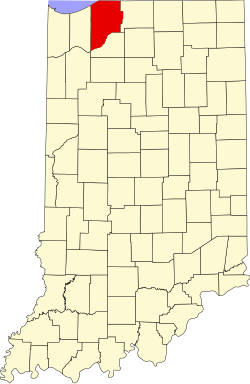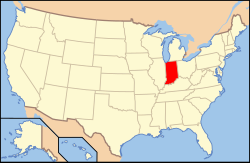History
LaPorte County was formed in 1832. La porte means "the door" or "the port" in French. [1] French travelers or explorers so named the area after discovering a natural opening in the dense forests that used to exist in this region, providing a gateway to lands further west. [8] [9]
From 1832 to 1835 LaPorte County had its boundaries and jurisdiction of the land west of it going all the way to the east border of Chicago in Cook County, IL (land which is now Porter and Lake Counties).
Before European-American settlement, all of the land that forms modern-day LaPorte County, and adjacent Starke County to the south belonged to the Potawatomi Indian nation. These Indians were forcibly removed to Kansas by the United States government in 1838, and many died on what survivors called the Trail of Death. [10] [11]
LaPorte County's initial European-American settlers were Yankee migrants, that is to say they were from New England or were from upstate New York and had parents who were from New England, and were descended from the English Puritans who settled New England in the colonial era. They were part of a wave of New England settlers moving west into what was then the Northwest Territory after the completion of the Erie Canal through the Mohawk Valley of New York State.
These first settlers in LaPorte County specifically hailed from the Massachusetts towns of Granville, Boston, Bridgewater, West Bridgewater, Andover, Nantucket Island, and Hampshire County; the Connecticut towns of Colchester, Wethersfield, Granby, and New Haven; the New Hampshire towns of Bradford, Amherst and Goffstown; the Vermont villages of Dorset, Albany and Fairfax; many also came from Orange County, Vermont, Caledonia County, Vermont and Penobscot County, Maine. They were mainly members of the Congregational Church. As result of the Second Great Awakening, many became Baptists and many also converted to Pentecostalism and Methodism. When they arrived in what is now LaPorte County, there was nothing but virgin forest and prairie. The New England settlers cleared roads and brush, developed farms, constructed churches, erected government buildings, and established post routes. As a result of this migration, La Porte County was partially culturally continuous with early New England culture for many years. [12]
But by 1850, the three Eastern states that had contributed the most residents to LaPorte County were New York, Pennsylvania and Virginia, surpassing those migrants from New England. LaPorte County had the largest number of Southerners north of the Wabash Valley. [13]
During the Civil War, the Louisville Journal noted that the 29th Indiana Regiment (mustered out of LaPorte) "may almost be regarded as a Kentucky regiment for a large majority of its members are either natives or descendants of native Kentuckians". [14] Three Union Camps reigned in LaPorte County helping the Union to Civil War victory.
When the county was initially proposed and organized, its boundaries did not extend as far south or east as they do today. A section of land north of the Kankakee River originally belonged to Starke County. However, residents living in that area had difficulty crossing the Grand Kankakee Marsh that surrounded the river in order to reach the rest of the county. It was necessary to travel some distance east to Lemon's bridge, before making the journey south. Effectively isolated from the rest of Starke County, these residents asked that their land be annexed to LaPorte County, which was completed on January 28, 1842. Thereafter, the Kankakee River formed the southern boundary of the county. Finally, on January 10, 1850, some twenty sections of land were annexed from St. Joseph County to the east, giving LaPorte County the boundaries that essentially exist to this day. [10]
Whether the correct spelling of the city and county is "La Porte" or "LaPorte" is disputed, [15] although state law refers to "LaPorte County." [16] [17]
LaPorte County is noted for being the last-known place of the Belle Gunness serial murders. Bodies of her victims were discovered after her house burned and she disappeared in 1908. Gunness lived on a farm on the outskirts of the county seat.
Demographics
Historical population| Census | Pop. | Note | %± |
|---|
| 1840 | 8,184 | | — |
|---|
| 1850 | 12,145 | | 48.4% |
|---|
| 1860 | 22,919 | | 88.7% |
|---|
| 1870 | 27,062 | | 18.1% |
|---|
| 1880 | 30,985 | | 14.5% |
|---|
| 1890 | 34,445 | | 11.2% |
|---|
| 1900 | 38,386 | | 11.4% |
|---|
| 1910 | 45,797 | | 19.3% |
|---|
| 1920 | 50,443 | | 10.1% |
|---|
| 1930 | 60,490 | | 19.9% |
|---|
| 1940 | 63,660 | | 5.2% |
|---|
| 1950 | 76,808 | | 20.7% |
|---|
| 1960 | 95,111 | | 23.8% |
|---|
| 1970 | 105,342 | | 10.8% |
|---|
| 1980 | 108,632 | | 3.1% |
|---|
| 1990 | 107,066 | | −1.4% |
|---|
| 2000 | 110,106 | | 2.8% |
|---|
| 2010 | 111,467 | | 1.2% |
|---|
| 2020 | 112,417 | | 0.9% |
|---|
| 2023 (est.) | 111,706 | [20] | −0.6% |
|---|
|
LaPorte County, Indiana – Racial and ethnic composition
Note: the US Census treats Hispanic/Latino as an ethnic category. This table excludes Latinos from the racial categories and assigns them to a separate category. Hispanics/Latinos may be of any race.| Race / Ethnicity (NH = Non-Hispanic) | Pop 2000 [26] | Pop 2010 [27] | Pop 2020 [28] | % 2000 | % 2010 | % 2020 |
|---|
| White alone (NH) | 93,330 | 90,695 | 85,957 | 84.76% | 81.36% | 76.46% |
| Black or African American alone (NH) | 11,052 | 11,835 | 11,874 | 10.04% | 10.62% | 10.56% |
| Native American or Alaska Native alone (NH) | 306 | 246 | 250 | 0.28% | 0.22% | 0.22% |
| Asian alone (NH) | 483 | 570 | 743 | 0.44% | 0.51% | 0.66% |
| Pacific Islander alone (NH) | 16 | 13 | 18 | 0.01% | 0.01% | 0.02% |
| Other race alone (NH) | 126 | 97 | 467 | 0.11% | 0.09% | 0.42% |
| Mixed race or Multiracial (NH) | 1,391 | 1,918 | 5,123 | 1.26% | 1.72% | 4.56% |
| Hispanic or Latino (any race) | 3,402 | 6,093 | 7,985 | 3.09% | 5.47% | 7.10% |
| Total | 110,106 | 111,467 | 112,417 | 100.00% | 100.00% | 100.00% |
As of the 2010 United States Census, there were 111,467 people, 42,331 households, and 28,228 families residing in the county. [29] The population density was 186.3 inhabitants per square mile (71.9/km2). There were 48,448 housing units at an average density of 81.0 per square mile (31.3/km2). [18] The racial makeup of the county was 84.1% white, 10.8% black or African American, 0.5% Asian, 0.3% American Indian, 2.0% from other races, and 2.3% from two or more races. Those of Hispanic or Latino origin made up 5.5% of the population. [29] In terms of ancestry, 30.7% were German, 15.3% were Irish, 11.5% were Polish, 8.3% were English, and 5.9% were American. [30]
Of the 42,331 households, 31.0% had children under the age of 18 living with them, 48.3% were married couples living together, 12.8% had a female householder with no husband present, 33.3% were non-families, and 27.3% of all households were made up of individuals. The average household size was 2.48 and the average family size was 3.00. The median age was 39.6 years. [29]
The median income for a household in the county was $47,697 and the median income for a family was $56,679. Males had a median income of $45,537 versus $30,774 for females. The per capita income for the county was $22,599. About 9.9% of families and 13.8% of the population were below the poverty line, including 22.7% of those under age 18 and 7.1% of those age 65 or over. [31]




